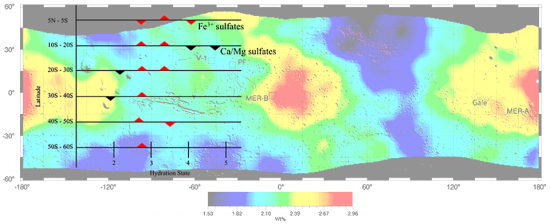
Mars sulfur concentration from the Mars Odyssey Gamma Ray Spectrometer. Credit: Nicole Button, LSU Planetary Science Lab
Apr 11, 2017
Mars stinks.
“The devil, he’s about this big.
He had a red suit on and a widow’s peak,
and then a pointed tail, and like a sulfur reek.
Yes, it was him alright, I swear.”
— Frank Zappa
If it were possible to stand on Mars unencumbered by a spacesuit, and with the ability to sense the environment, the odor of spent gunpowder or a burned match head would be instantly noticeable. This is because Mars contains rich sulfur deposits.
In 1976, the Viking probes detected sulfur compounds up to 3% by weight in the Martian regolith. Soil samples from the two landing sites, Chrsye Planitia and Utopia Planitia, were remarkably similar despite being more than 6000 kilometers apart. Mission engineers speculated that Mars once experienced what they called “homogenizing events”, such as planet-wide dust storms, that mixed the soils into uniform beds.
Magnesium sulfate, commonly called “Epsom salt” was found by the Spirit rover as it traveled through an area of deep powder on the way to “McCool Hill” in 2006. Spirit’s rear wheel was jammed by that time, causing it to drag instead of spin. The locked wheel churned up the ground, revealing bright material just below the surface.
Sulfur on Mars is compounded into sulfates that seem to indicate a “long soak in water”. According to a recent press release, magnesium sulfate accumulation shows that the mineral remained submerged for a long time after formation. It is conventionally presumed that Mars was wet at some time in its past, so the sulfates provide theorists with potential confirmation.
“Wet Mars” is a popular theory because orbiting satellites and ground-based rovers observe features that cannot be created from wind erosion—especially since the thin atmosphere on Mars means it would take a thousand years to move a “sand dune” just a few meters. Deep trenches, mesas, ripples and other structures, are thought to be due to “floods of water” sculpting the topography like it does on Earth.
Theories propose that there were oceans on Mars (“millions of years ago”), so the chemicals that form in or with water here are presumed to form there by the same process. Despite observations revealing mineral deposits that would be destroyed by water, such as olivine, the flowing water theory guides theories of Martian areology.
Previous Picture of the Day articles argue for an alternative theory, proposing that electric arcs played a major role in forming the structures on Mars. Careful investigation into Valles Marineris, Olympus Mons, Argyre Planitia, Arabia Terra and both Martian poles demonstrates strong support for the electric discharge theory. Those same electric discharges on Mars could have transmuted silicon into iron and reformed silicon dioxide rock layers into the vast fields of hematite “blueberry” spherules that litter the landscape. Sulfur on Mars most likely resulted from similar catastrophic events.
Electric arcs are capable of transmutation, so it is also suggested that Jupiter’s moon, Io, transmogrifies oxygen from water into sulfur, resulting in sulfur “volcanoes” on its surface. According to Electric Universe theory, the volcanoes are the touchdown points where the plasmasphere of Jupiter completes its electrical circuit with Io.
The sulfur on Io and the sulfur on Mars are most likely two results from the same effect. Io has no plasma sheath and neither does Mars, so nothing absorbs the stress of the solar wind on Mars or Jovian electric currents on Io. Instead, charge flow impinges directly. All the chemical compounds attributed to water might be because the current flow was much stronger in the recent past. That Solar System wide cataclysm pulverized the materials, compressed them in z-pinch zones, exposed them to intense shock and magnetic force fields, and then finally deposited them in layers following rapid cathode sputtering.
A sulfurous odor is sometimes reported along with the typical ozone smell after thunderstorms have passed. Lightning bolts are strong enough to change some oxygen in the atmosphere into sulfur dioxide. After an “electric dust devil” passes by on Mars that same stench is most likely present. If the idea that gigantic electric arcs carved Valles Marineris is correct, a great deal of sulfur might have been created and spread around the planet.
Stephen Smith












